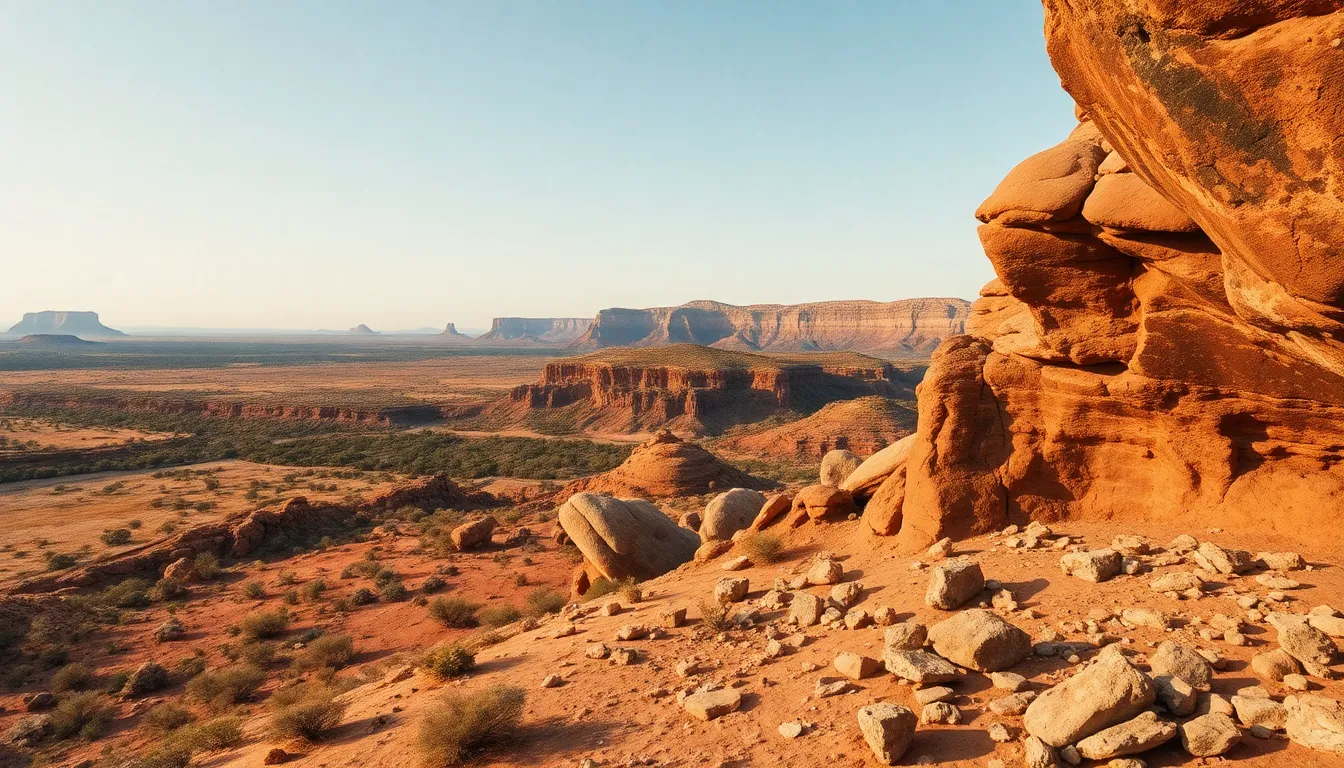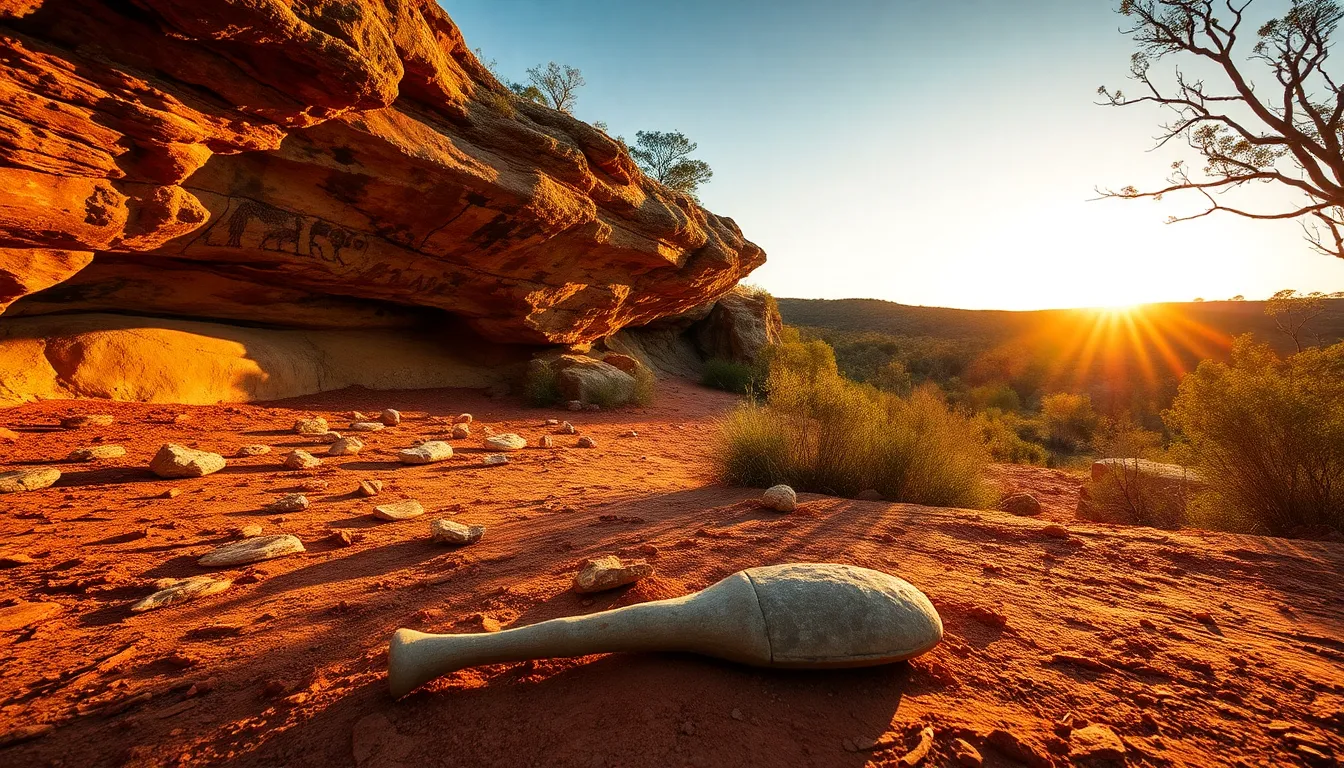Australia’s history is as vast and intriguing as its outback. While many know about the rich culture and traditions of Aboriginal peoples, few realize that the continent has a mysterious past that predates their arrival. What if the land was once home to other inhabitants? Buckle up, because this journey into the depths of time reveals a world that’s both fascinating and a bit perplexing.
Table of Contents
ToggleWho Was in Australia Before the Aboriginal
Evidence suggests earlier inhabitants existed in Australia before the Aboriginal peoples. Archaeological finds indicate human presence dating back over 65,000 years. These ancient people may have arrived from Africa via a land bridge or island-hopping routes.
Researchers propose these groups consisted of hunter-gatherers who adapted to Australia’s diverse environments. They might have utilized tools made of stone and bone to hunt native megafauna. Fossils discovered in places like Lake Gnotuk and in northwestern Tasmania reveal the existence of these large animals, including the Diprotodon and the Megalania.
Excavations at sites like the Naracoorte Caves show the complexity of this vibrant society. The remains at these sites illustrate not only diet but also cultural practices unique to this early population. Rock art, although often associated with Aboriginal cultures, raises questions about previous creators and their expressions.
In addition to these prehistoric data, recent genetic studies explore possible connections between early inhabitants and modern Aborigines. Findings highlight a complex migration and settlement pattern across the continent. These insights deepen the understanding of how human life evolved in Australia.
Different theories exist regarding the origins and lives of these inhabitants. Some scientists suggest environmental changes influenced their migration patterns, while others emphasize cultural adaptations. Further studies may provide clarity on these early groups and their legacy in shaping Australia’s history.
The Arrival of First Peoples

Ancient inhabitants arrived in Australia over 65,000 years ago. Various migration theories propose routes from Africa, utilizing land bridges or island-hopping.
Migration Theories
Multiple theories exist regarding how the first peoples reached Australia. One theory suggests migration through Southeast Asia, which included crossing land bridges during lower sea levels. Another theory indicates a maritime route, where seafaring communities navigated coastal waters. These early populations likely adapted to diverse landscapes, allowing for varied subsistence strategies. Some researchers emphasize the potential for multiple migration waves, contributing to Australia’s rich cultural heritage.
Archaeological Evidence
Archaeological discoveries illuminate the lives of these early inhabitants. Fossils in places like Lake Gnotuk reveal their interactions with native megafauna. Excavations at Naracoorte Caves showcase dietary habits and sophisticated tool use. Rock art, found across various sites, hints at a complex social structure and belief systems. Genetic studies complement these finds, linking ancient populations to modern Aboriginal communities and underscoring the continuity of cultural practices.
Ancient Cultures and Societies
Australia’s ancient history features intriguing evidence of societies predating the Aboriginal peoples. These early inhabitants left rich cultural traces, including their remains and artifacts.
The Mungo Man and Woman
The discovery of Mungo Man and Mungo Woman provides critical insights into early human life in Australia. Found near Lake Mungo, these remains date back approximately 42,000 years. Mungo Man represents one of the oldest known human burial sites on the continent, showcasing ritualistic behaviors. Detailed analysis of these skeletons reveals physical characteristics distinct from modern populations. Their burial practices hint at a complex belief system and social structure. Studies of these ancient remains suggest survival strategies adapted to a harsh environment, indicating a resilient community flourishing long before Aboriginal presence.
Early Art and Tools
Ancient Australians produced remarkable artworks and tools reflecting their sophisticated culture. Rock engravings and paintings found in various locations illustrate intricate designs and symbols. Dating back at least 30,000 years, these artworks provide a glimpse into the spiritual beliefs and daily life of these societies. Tool use was equally advanced, with evidence of well-crafted stone implements. These early tools facilitated hunting and gathering, showing their adaptability to different environments. Significant archeological findings, such as those at Lake Gnotuk, underscore their creative expression and innovative skills, laying a foundation for later Aboriginal cultures.
Influence on Australia’s Biodiversity
The ancient populations of Australia significantly influenced the continent’s biodiversity through their interactions with the environment.
Prehistoric Megafauna
Prehistoric megafauna roamed Australia during the arrival of early inhabitants. Creatures such as Diprotodon, the giant wombat, and the massive Megalania, a giant monitor lizard, thrived in diverse ecosystems. Evidence shows that these early people hunted these animals, influencing their populations and contributing to extinction. Fossils found at sites like Lake Gnotuk underscore their diverse diets and ecological relationships. Nihilistic hunting practices may have contributed to the departure of many megafaunal species. This interaction highlights the delicate balance between human activity and wildlife populations.
Ecosystem Changes
Ecosystem changes arose as ancient inhabitants adapted to different environments. Early human activity shifted plant and animal populations, introducing new foraging techniques and practices. Fire management transformed landscapes, promoting new growth and influencing species diversity. Evidence suggests controlled burns created habitats for specific plant and animal species. Additionally, alterations in land use patterns initiated long-lasting modifications in the natural environment. These changes ultimately laid the foundation for contemporary biodiversity in Australia, woven into the fabric of its ecosystems.
Modern Implications and Recognition
The influence of Australia’s ancient peoples extends into contemporary discussions about rights and heritage. Indigenous rights play a crucial role in acknowledging the historical significance of pre-Aboriginal inhabitants. Shedding light on their contributions enriches the narrative of Australia’s history, leading to greater recognition of Indigenous cultures.
Indigenous Rights and Heritage
Recognition of Indigenous rights highlights the need for respect towards land ownership and cultural heritage. Establishing laws that protect these rights fosters an environment where Indigenous voices are heard. Engaging with Indigenous leaders promotes the preservation of ancient knowledge and traditions. Legal frameworks often empower communities to reclaim their cultural sites. Such actions not only honor past inhabitants but also ensure their legacies persist in modern society. Ongoing dialogues reflect a societal shift towards reconciliation, emphasizing the importance of understanding Australia’s entire historical tapestry. Education initiatives further encourage awareness and appreciation of Indigenous heritage among Australians.
Australia’s history is rich and complex with layers that extend beyond the well-known narratives of Aboriginal peoples. The evidence of earlier inhabitants reveals a deep connection to the land that predates modern understanding. These ancient populations not only adapted to diverse environments but also left behind a legacy of culture and innovation that continues to resonate today.
Recognizing these early societies is crucial for appreciating the full tapestry of Australia’s past. It invites ongoing discussions about Indigenous rights and heritage while fostering respect for the land and its original stewards. As more discoveries emerge, the story of Australia’s first peoples continues to evolve, enriching the nation’s identity and cultural heritage.








